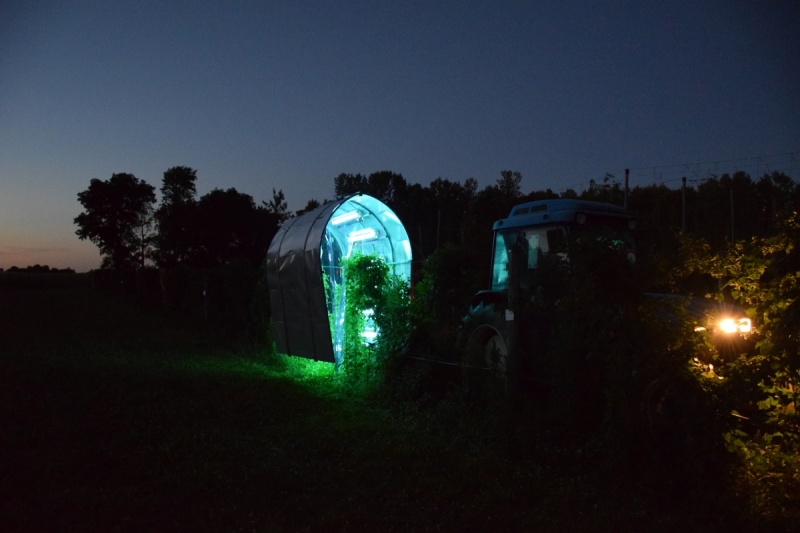Apr 30, 2019UV light can kill fungi that causes powdery mildew
Growers may no longer have to rely on fungicides to control powdery mildew (PM) – a rampant fungal disease that affects nearly all plant species. The international, multidisciplinary Light and Plant Health team of researchers led by Cornell AgriTech’s David Gadoury has spent the last five years refining the science and applied technology behind using ultraviolet (UV) light to kill the fungi that cause PM.
“In more than three years of trials, UV light applications worked as well or better than available fungicides, killing 95 percent of PM in field strawberries. We’ve seen similar results in field and greenhouse trials of basil, roses, grapes and cucumbers,” said Gadoury, senior research associate in the Section of Plant Pathology and Plant Microbe-Biology in the School of Integrative Plant Science.
Controlling crop diseases is a complicated process of managing resistance to available treatments while fighting multiple pests on multiple fronts. Gadoury said that if farmers can knock out PM – one of the most difficult pathogens to suppress with fungicides – they can more efficiently manage the remaining diseases and insect pests. Using UV light to do this allows growers to use fewer fungicides, preserve their effectiveness and see significant savings.
This option is especially critical for organic growers, who have a more limited arsenal of control measures. And, for high-value specialty crops like strawberries, grapes and greenhouse cucumbers – which are some of the most heavily sprayed – using UV light could expand organic production. The team’s work is supported by a $1.7 million Organic Agriculture Research and Extension Initiative grant from the U.S. Department of Agriculture, as well as major grants from the USDA Specialty Crop Research Initiative, the USDA Crop Protection and Pest Management program and the National Research Council of Norway.
“Wish Farms is the largest producer of organic strawberries in Florida. Currently, there is not a good way to deal with powdery mildew in organics. This technology is going to assure us control. Anytime we can reduce or eliminate pesticides, it is a huge plus,” said Gary Wishnatzki, owner of Wish Farms, which has trial tested UV light treatments at some of its nearly 250 acres of organic strawberries.
The science and technology to which Wishnatzki refers is strikingly simple. Fungi have evolved light-sensing systems, which they use to control their development. They also have a system that rapidly repairs DNA damaged by constant exposure to UV light. Eight years ago, project partners Aruppillai Suthaparan and Arne Stensvand, at the Norwegian Institute of Bioeconomy Research (NIBIO), discovered that powdery mildew fungi shut down this repair mechanism at night. The researchers were then able to exploit this weakness, exposing fungi to a small amount of UV light at night – killing the pathogen without harming the plants.
To move this critical discovery from the lab to growers required the combined talents of a diverse project team from Cornell, the University of Florida Gulf Coast Research and Education Center, Rensselaer Polytechnic Institute, the USDA Agricultural Research Service Grape Genetics Research unit, NIBIO and the Norwegian University of Life Sciences. The team has now defined UV light wavelengths and doses for a variety of crops and conditions while also developing inexpensive, efficient lighting and delivery systems—such as low-tech tractor attachments.
This year, growers will have more chances to see the effects of UV light on crops: Working with leading growers and extension divisions across the U.S., the team will conduct nearly 20 trials with strawberries, squash, pumpkins, cucumbers, grapes, hops, basil and industrial hemp. In New York, the first commercial grapevine field trial will run in Hammondsport at Bully Hill Vineyards, which also is a sponsor and partner in related research at Cornell AgriTech.
“Sustainable viticulture is a foundation on which Bully Hill has built its success, and UV technology is a game changer for our spray program. We’re at the mercy of Mother Nature when applying fungicides, and powdery mildew is constantly evolving to combat the effectiveness of current formulations,” said Greg Taylor, director of sales and son of winery founder Walter Taylor. “We anticipate that any increased labor costs from nighttime application will be offset by savings from buying and managing less chemicals.”
– Sarah Thompson is a freelance writer with Cornell AgriTech.
Photo at top: A team of researchers led by Cornell AgriTech’s David Gadoury has spent the last five years refining the science and applied technology behind using ultraviolet (UV) light to kill the fungi that cause powdery mildew. This year, the team will work with leading growers and extension divisions across the US to conduct nearly 20 trials with numerous crops. Above, UV light technology being used at night to suppress powdery mildew on grapevines at a Cornell AgriTech research field. Photo: David Gadoury

















